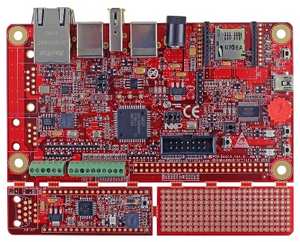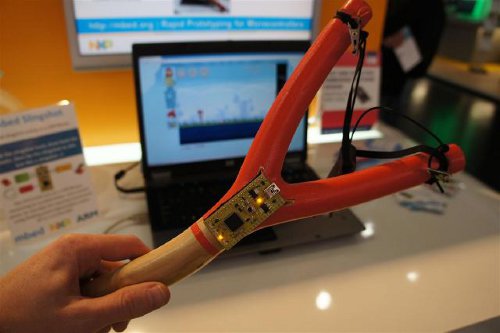Embedded Artists and NXP introduced the TN-20764, a board that can be used with Android Open Accessory Application (AOAA) development kit that features 2 NXP Cortex-M MCUs, at Embedded World 2012. The board includes Ethernet, CAN and IEEE 802.15.4 interfaces as well as a remote CAN node, enabling designers to develop accessories for consumer applications, as well as home, building and industrial automation applications requiring different types of connectivity. There are already Arduino and PIC-based Android Open Accessories, but this board is the first AOAA kit based on ARM Cortex-M micro-controllers. As mentioned above, the board features 2 Cortex M micro-controllers: The NXP LPC1769, a 120-MHz Cortex-M3 based MCU, provides the interface to the Android mobile device via its full-speed USB transceiver . The LPC1769 also includes 512 KB flash and 64 KB on-chip SRAM, an Ethernet MAC, a CAN 2.0B controller, an 8-channel, a 12-bit ADC, a 10-bit DAC, […]
Play Angry Birds For Real with Mbed NXP Cortex-M0 Slingshot
If you’re just bored to play Angry Birds with the touchscreen of your smartphone or with your mouse in Angry Birds for Chrome, you can now bring the fun back to the game by playing with a real slingshot ! mbed designed a USB slingshot with an mbed NXP LPC11U24 (Cortex-M0 MCU) board that emulates a USB mouse. mbed measures the angle and strength applied with: An accelerometer that measure the tilt by tracking the gravity vector A rubber stretch sensor used as the sling, and measure how much it is stretched. They built the slingshot with the following hardware components: mbed NXP LPC11U24 board – 59 USD 3-axis Accelerometer – ADXL345 Accelerometer connect via SPI – 14.95 USD Stretch Sensor connected to pin 15 (analog input) – 9.95 USD USB B connector Handcrafted Slingshot Here’s how mbed describes their NXP board: The mbed NXP LPC11U24 MCU module is a […]
Texas Instruments OMAP5 Demo at MWC 2012
Charbax of armdevices.net has uploaded a very interesting video with an OMAP5430 demo and an interview at Texas Instruments booth at MWC 2012. Using the OMAP5 development kit, they demo several 3D applications, the web browser and the picture gallery and it looks extremely smooth. They discussed about the OMAP5 vs Tegra 3 benchmark, and it appears mobile web browsers are not yet optimized for more than 2 cores which could explain the performance difference somewhat. The OMAP5 currently runs at 800 MHz, but there will eventually be 2 versions: 1.7 and 2.0 GHz when the OMAP 5 AP is released. This should show a performance improvement of over 4x against the Tegra 3, although I’m sure in the meantime, Nvidia will have announced the Tegra 4 (Wayne). The OMAP 5 also offers impressive improvement in power consumption, as the SGX544 GPU cores are augmented by a dedicated 2D hardware-accelerated […]
Linux on eMMC: Optimizing for Performance – ELC 2012
Ken Tough, principal engineer at Intrinsyc Software, discusses Linux on eMMC at Embedded Linux Conference 2012. Abstract: Embedded devices are increasingly choosing eMMC instead of raw NAND flash as their main storage, for increased independence from component vendors and changing storage densities. This presentation examines Linux configuration for eMMC, how to effectively measure your eMMC performance, and tips to improve it. Topics covered include: filesystem bearing on MMC/SD performance, IO scheduler configuration, and optimal partition layout. Target audience is embedded systems developers or users interested in getting the most out of their eMMC/SD card. You can also download the presentation slides on elinux.org. Jean-Luc Aufranc (CNXSoft)Jean-Luc started CNX Software in 2010 as a part-time endeavor, before quitting his job as a software engineering manager, and starting to write daily news, and reviews full time later in 2011. www.cnx-software.com
HiSilicon Unveils Quad-Core Cortex A9 K3V2 Processor (Hi3620)
HiSilicon, a subsidiary of Huawei, has unveiled the K3V2 quad-core cortex A9 processor at mobile world congress 2012, Barcelona. The processor comes in two version 1.2 and 1.5 GHz and the company claims the chip delivers 30 to 50 percent more performance than existing quad-core processor including the NVidia Tegra3. This performance boost is apparently possible thanks to a 64-bit memory bus as well as a powerful 16-core GPU (by an unnamed US chip designer) that is at least twice as fast as the competition. The current versions of the chip are manufacturer using TSMC 40 nm low power process, but the company plans to move to 28-nm technology for further power efficiency later this year. They do not use a companion core like the NVidia Tegra 3 to save power, but instead HiSilicon designed an A.I.PS (Artificial Intelligence Power Scaling) Core in K3V2, which can manage cores CPU and […]
Qualcomm Showcases Glasses-Free 3D Tablet Powered by SnapDragon S4 Processor
Mobile World Congress 2012 starts today and we should get a flood of announcements today. In the video below, Qualcomm showcases their Snapdragon S4 quad-core processor in a developer tablet showing 4 independnat videos decoded by the 4 cores and a 3D game demo taking advantage of the faster GPU (50% faster than the previous generation). They also showcase the Snapdragon S4 dual-core MDP Tablet with Full High-Definition glasses-free 3D display in WUXGA (1920×1200) resolution. This tablet also has 2 8MP rear camera in order to capture 3D movies and photos. Jean-Luc Aufranc (CNXSoft)Jean-Luc started CNX Software in 2010 as a part-time endeavor, before quitting his job as a software engineering manager, and starting to write daily news, and reviews full time later in 2011. www.cnx-software.com
LAVA Project Update – ELC 2012
Paul Larson of Linaro gives a LAVA Project update at Embedded Linux Conference 2012. Abstract: The Linaro Automated Validation Architecture (LAVA) is an open source framework used at Linaro for running automated tests on Ubuntu and Android based images, kernels, and more. I introduced LAVA at ELC a year ago. Since that time, considerable progress has been made on the project, and many new components have been added to it. This talk will briefly re-introduce the project to those who may not have heard about it, as well as introduce the new developments. You can download the presentation slides at elinux.org. Jean-Luc Aufranc (CNXSoft)Jean-Luc started CNX Software in 2010 as a part-time endeavor, before quitting his job as a software engineering manager, and starting to write daily news, and reviews full time later in 2011. www.cnx-software.com
Status of Embedded Linux – ELC 2012
Tim Bird, software engineer at Sony, discusses recent development in embedded Linux at the Embedded Linux Conference 2012. Abstract: Tim discusses changes to the kernel, improvements to embedded-related sub-systems, and new industry initiatives likely to affect embedded Linux developers in the future. Also, Tim discusses the direction of the Linux Foundation CE Workgroup, and their contract work and projects for this year. Last year highlights are also discussed, as well as ways to continue to improve Linux going forward. Here are the key points of this presentation: Linux Kernel Version changes: 2.6.38 to 3.3-rc3 Technology Areas: Bootup Time – With improvement in the kernel, bootloader and user-space Graphics – 2D/3D implementation. New /dev/ion and CMA graphics stuffs Accelerated Rendering – e.g. Renderscript Graphics Drivers – e.g. PowerVR Multimedia – Gstreamer, Android Media Layer (stagefright) and codec wars (e.g. patent issues with WebM/VP8 that interferes open source licenses). File systems – […]





